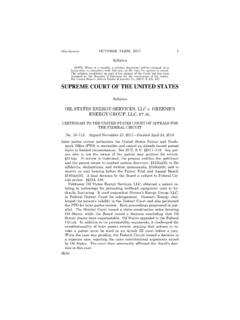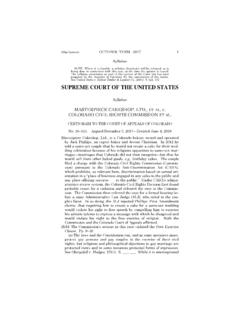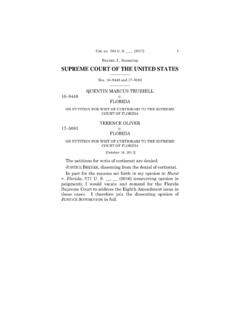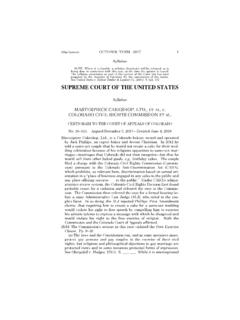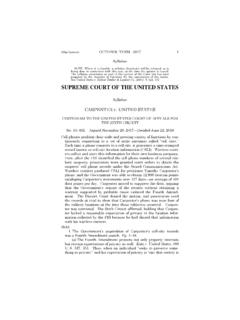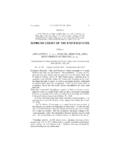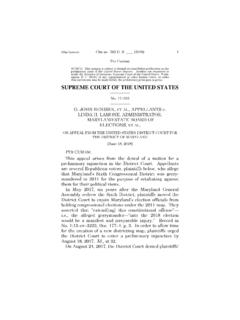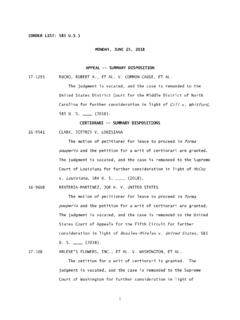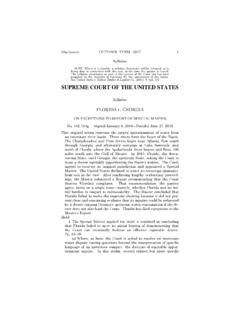Transcription of Rules of Statutory Construction and Interpretation
1 App. Al Rules of Statutory Construction and Interpretation All the "terms" used by government opponent "United states ", myself, and the Court, the following Rules of Statutory Construction and Interpretation MUST apply. I. The law should be given it's plain meaning wherever possible. Statutes must be interpreted so as to be entirely harmonious with all laws as a whole. The pursuit of this Harmon is often the best method of determining the meaning of specific words or provisions which might otherwise appear ambiguous. It is, of course, true that Statutory Construction "is a holistic endeavor" and that the meaning of a provision is "clarified by the remainder of the Statutory scheme .. [when] only one of the . permissible meanings produces a substantive [532 US 218] effect that is compatible with the rest of the law." United Say. Assn. of Tex. v Timbers of Inwood Forest Associates, Ltd., 484 US. 365, 371, 98 L Ed 2d 740, 1085 Ct 626 (1988).
2 [ v. Cleveland Indians Baseball Co., 532 200, 220 (2001)]. Every word within a statute is there for a purpose and should be given its due significance. This fact only underscores our duty to refrain from reading a phrase into the statute when Congress has left it out. '[W]here Congress includes particular language in one section of a ". statute but omits it in another it is generally presumed that Congress acts intentionally and .. , purposely in the disparate inclusion or exclusion.' "Russello v United states , 464 US 16, 23, 78. LEd 2d 17, 104 S Ct 296 (1983). [Keene Corp. v United states , 508 200 (1993)]. All laws are to be interpreted consistent with the legislative intent for which they were originally enacted, as revealed in the Congressional Record prior to the passage. The passage of no amount of time can change the original legislative intent of a law. Courts should construe laws in harmony with the legislative intent and seek to carry our legislative purpose.
3 [Foster v. United states , 303 118, 120 (1938)]. We are bound to interpret the Constitution in the light of the law as it existed at the time it was [Mattox v. United states , 156 237, 244, 15 S. Ct. 337, 39 L. Ed. 409 (1895)]. Presumption may not be used in determining a statute. Doing otherwise is a violation of due process and a religious sin under Number 15:30 (Bible). A person reading a statute cannot be required by statute or by "judge made law" to read anything into a Title of the Code that is not expressly spelled out. See: Presumption: Chief Weapon for Unlawfully Enlarging Federal Jurisdiction, Form # The proper audience to turn to in order to deduce the meaning of a statute are the persons who are the subject of the law, and not a judge. Laws are supposed to be understandable by the common man because the common man is the proper subject of most laws. Judges are NOT common men. It is a basic principle of due process that an enactment is void for vagueness if its prohibitions are not clearly defined.
4 Vague laws offend several important values. First, because we assume that man is free to steer between lawful and unlawful conduct, we insist that laws give the Person of ordinary inteii&nce a reasonable opportunity to know what is prohibited, so that he may act Vague laws may trap the innocent by not providing fair warning. App. A2. Second, if arbitrary and discriminatory enforcement is, to be prevented, laws must provide explicit standards for those who apply them. A vague <*pg. 228> law impermissibly delegates [408 Us ioj basic policy matters to policemen, judges, and juries for resolution .on an ad hoc and subjective basis, with the attendant dangers of arbitrary and discriminatory application. [Grayned v. City of Rockford, 408, 104 (1972)] '. whether right or wrong, the premise underlying the constitutional, methodfordetermining guilt or innocence in federal courts is that laymen are better than specialists to perform this task.]
5 ,, .,. ,.. , .. [Toth ,uarles, 350 11 (1955)] ..,.. If a word is not statutorily defined, then the courts are bound to start with the common law meaning of the term. Absent contrary direction from Congress, we-begin our Interpretation of Statutory language: with the general presumption that a Statutory term has its common-law meaning. See 'Taylor. v. United states , 495 US 575, 592, 109 L Ed2d 607, 1105 Ct 2143 (1990); Morissette v. United states , 342 US 246, 263, 96 L Ed 288, 72S Ct 240(1952).'. , ' ,'. [Scheidler v. Nat'l Org. for women , Inc., 537 393 (2003)]. The purpose for defining a word within .a statute is so that its ordinary (dictionary) meaning is not implied or assumed, by the reader. A "definition" by its terms, excludes non-essential elements by mentioning only those things to which it shall apply. Define To explain or state the exact meaning of words and phrases to state explicitly to limit;. to determine.
6 Essential qualities of; to determine the , precise .signification of; to -settle,, to establish :' prescribe. authoritatively; to make clear (Cite omitted). To define with respect to space means to set or establish its boundries authoritatively to mark the limits of; to determine with precision or exhibit clearly the boundaries of;. to determine the end or limit; to fix or establish the limits. it is' the equivalent to 'declare, fix or'. establish. [Black's Law Dictionary, .Sixth Edition, p. 422]. Definition. A description of a thing by its properties; an explanation of the meaning of a word or term. The process of stating the exact meaning of a word by means of other Such a description of the thing defined, including all essential elements and excluding all nonessential, as to distinguish it from all other things and classes. [Black's Law Dictionary, Sixth Edition, p. 423]. When a term is defined within a statute, that definition is provided to supersede and not enlare other definitions of the word found elsewhere, such as in other Titles or Codes.
7 When a statute includes an explicit definition, we must follow that definition, even if it varies from that term's ordinary meaninjz. Meese v Keene, 481 US 465, 484-485, 95 L Ed 2d 415, 107. S Ct 1862 (1987) ("It is axiomatic that the Statutory definition of the term excludes unstated meanings of that term"); Colautti v Franklin, 439 US at 392-393, n 10, 58 L Ed 2d 596, 99 5 Ct 675' ("As a rule, 'a definition which declares what a term "means". excludes any meaning .. that is not stated' "); Western Union Telegraph Co. v Lenroot, 294 US 87, 95-96, 79 L Ed 780, 55 5 Ct 333 (1935) (Cardozo, J.); see also 2A N. Singer Sutherland on Statutes and Statutory Construction , p 152, and n 10 (5th ed. 1992) (collecting cases). That is to 'say, the statute, read "as a whole, post, at 147 L Ed 2d, at 800 (Thomas, J., dissenting), leads the " , reader to a definition. That definition' does not include the Attorney General's restriction- "the child up to the head.
8 " its words, "substantial portion, "indicate the contrary. App. A3. [Stenberg v. Carhart, 530 914 (2000)]. A converse of the rule that courts should not read Statutory language as surplusage is that courts should not add language that congress has not To do so, given the "Particularization and detail" with which congress. had set out the categories, would amount to "enlargement" of the statute rather than " Construction " of it. [CRS Report for congress (2008) 97- 589 Pg'c'RS-B]. - . '. 10. It is a violation of due process of law to employ a " Statutory presumption", whereby the reader is compelled to guess about precisely what is included in the definition of a word, or whereby all that is included within the meaning of a term defined is not described SOMEWHERE within the body of law or Title in question. , The Schlesinger Case has since been applied many times by the lower federal courts, by the Board of Tax Appeals, and by state courts; and <*pg.
9 779> none of them seem to have been at any loss to understand the basis of the decision, namely; that a statute which imposes a tax .upon an assumption of fact which the taxpayer is forbidden to cOntrovert,' is so arbitrary and unreasonable that it cannot stand under the 14th Amendment. ]. A rebuttable presumption clearly is a rule of evidence which has the effect of shifting the burden of proof, Mobile, J. & K. C. R. Co. v. Turnipseed, 219 U. S. 35, 43, 55 L. ed. 78,80, 32': ( ) 226, 31 S. Ct. 136, Ann. Cas. 1912A, 463, 2 N. C. C. A. 243; and it is hard to see how a Statutory rebuttable presumption is , turned' from a rule of evidence into a rule of". substantive law as the: result of a 'lateItatute making it conclusive. In both cases it is a substitute for proof; in the one open to challensie and disproof, and in the other conclusive.". However, whether the latter presumption be treated as a rule of evidence or of substantive law, it constitutes an attempt, by leRilative fiat, to enact into existence <*p.
10 781> a fact which here does not, and cannot be 'made to, exist in actuality, and the result is the same, unless we are ready to overrule the Schlesinger Case, as we are not; for that case dealt with a conclusive presumption and the court held it invalid without regard to the question of its technical characterization. This court has held more than once that a statute creating a '. presumption which operates to deny a fair opportunity to rebut it violates the due process clause of the 14th Amendment. For example, Bailey v. Alabama, 219 U. S. 219, 238 et seq., 55. L. ed. 191,'200, 31 S. Ct. 145; Manley v. Georgia, 279 U. S. 1, 5, 6, 73 L. ed. 575, 577, 578,. 49. S. Ct. 2]5. "It is apparent," this court said in the Bailey Case (p. 239) "that a constitutional prohibition'. cannot be transgressed indirectly by the creation of a Statutory presumption any more than it can be violated .by direct enactment. The power to create presumptions is not a means of escape from constitutional restrictions.
